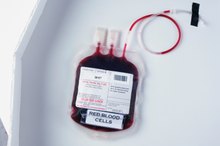Iron Supplements for Teens
From crash dieting to eating fast food on the run, teens often lack crucial nutrients in their diets. Getting enough iron is especially important for teen girls, who need more many other populations. While red meat, dried peas and other foods offer sources of iron, to get enough some teens may need take iron supplements, which can be found in multivitamins or as separate supplements.
Iron Deficiency
When teens have growth spurts, their bodies need more nutrients, including iron, according to the Centers for Disease Control (CDC). Girls need nearly twice as much iron as boys because iron can be lost during menstrual periods. Because red meat is a good source of iron, vegetarian teens may be at greater risk for iron deficiency. When too little iron is consumed, teens may be diagnosed with iron deficiency anemia, the most common type of anemia in this age group. In anemia, too little iron can cause hemoglobin and red blood cell production to slow. As a result, a teen may become pale and frequently feel tired, notes TeensHealth.org.
- When teens have growth spurts, their bodies need more nutrients, including iron, according to the Centers for Disease Control (CDC).
- When too little iron is consumed, teens may be diagnosed with iron deficiency anemia, the most common type of anemia in this age group.
How Much Iron is Required
Signs & Symptoms of Iron Deficiency in Teens
Learn More
The National Library of Medicine's Medline Plus recommends males age 9 to 13 get 8 mg per day of iron, while teen boys age 14 to 18 consume 11 mg. Girls need 8 mg when they are age 9 to 13, but the requirement jumps to 15 mg at ages 14 to 18.
Supplementing Iron in the Diet
Teens should strive to eat iron-rich foods, including red meat, spinach, dried beans, eggs and fortified cereals, the CDC recommends. But if a teen is diagnosed with anemia, supplements are prescribed by a doctor. Iron supplements are available in two forms: ferrous and ferric. Ferrous iron salts (ferrous fumarate, ferrous sulfate and ferrous gluconate) are the best absorbed forms of iron supplements, according to the National Institutes of Health Office of Dietary Supplements. Brand names of supplements include Feosol, Femiron, Elite Iron and Fergon.
- Teens should strive to eat iron-rich foods, including red meat, spinach, dried beans, eggs and fortified cereals, the CDC recommends.
- Ferrous iron salts (ferrous fumarate, ferrous sulfate and ferrous gluconate) are the best absorbed forms of iron supplements, according to the National Institutes of Health Office of Dietary Supplements.
Supplement Side Effects
Folic Acid for Teens
Learn More
While iron supplements improve anemia, they can have side effects, such as nausea, vomiting, constipation and diarrhea. The Office of Dietary Supplements recommends trying half the recommended dose first and gradually increasing the amount to help prevent these problems. Taking supplements with food can also minimize side effects, as does taking coated or time-release tablets. In addition, Vitamin C increases iron absorption, so consuming orange juice or citrus fruits at the same time as swallowing an iron supplement is a good idea, according to TeenHealth.org.
- While iron supplements improve anemia, they can have side effects, such as nausea, vomiting, constipation and diarrhea.
- Taking supplements with food can also minimize side effects, as does taking coated or time-release tablets.
Related Articles
References
- TeensHealth: Anemia
- Medline Plus: Iron in Diet
- National Institutes of Health: Office of Dietary Supplements: Iron
- https://www.who.int/elena/titles/guidance_summaries/daily_iron_pregnancy/en/
- Tolkien Z, Stecher L, Mander AP, Pereira DI, Powell JJ. Ferrous sulfate supplementation causes significant gastrointestinal side-effects in adults: a systematic review and meta-analysis. PLoS One. 2015;10(2):e0117383. doi:10.1371/journal.pone.0117383
- National Institutes of Health Office of Dietary Supplements. Iron Fact Sheet for Consumers. Updated December 10, 2019.
Writer Bio
Barbara Ruben has been a journalist for over 25 years. She has written extensively for the "Washington Post" and served as editor for an international health-care magazine and a group of newspapers for older adults. She earned a master's degree in journalism from Indiana University.









